The Very Big Picture behind what we do
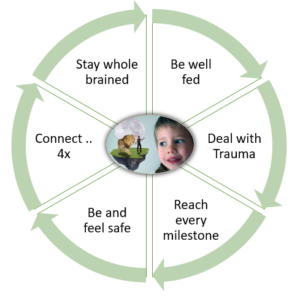
When we look for what is happening to a child that prompts the behaviours being seen, we look in 6 areas:
- How safe are they and how safe do they feel?
- How much of their trauma has been resolved?
- Can they connect to themselves, a primary caregiver, their family and the community?
- Do they have tools for staying whole brained under stress? ANY stress?
- Is their brain getting the nutrients it needs to function? This includes allergies and gut issues.
- Have they reached every milestone? Yes EVERYONE of them, and head control in particular.
Once we know what is happening in each, we can then choose what to address and in what order.
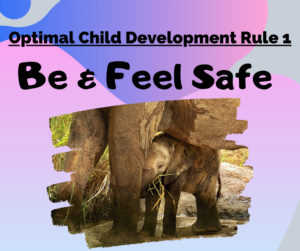 Chances are that if there is a safety issue that gets to be dealt with pretty quickly. Safety is complicated and when safety was, or is, jeapodised by trauma, the complication is even bigger.
Chances are that if there is a safety issue that gets to be dealt with pretty quickly. Safety is complicated and when safety was, or is, jeapodised by trauma, the complication is even bigger.
In this arena we often look very closely at parenting tools. These are not always easy conversations, and help for children is often dependent on their adults being part of the growth. We know this, have been there, learned many tricks and have ways that succeed if you do them.
If trauma has been part of what has influenced behaviour, 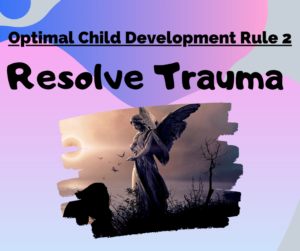 we address this mainly through body work and sound. We have a trauma protocol that removes the soft tissue memory of the incidents without us ever having to talk about them.
we address this mainly through body work and sound. We have a trauma protocol that removes the soft tissue memory of the incidents without us ever having to talk about them.
This is often part of freeing up the person's neck and affects active head control. It releases the Tendon Guard Reflex - a defensive stance (which means a specific group of muscles tightened) we all assume under threat even if we freeze.
This can be a near drowning, a bully situation, a car accident, the dog dying... and the list of traumatising events really is endless. We can and do address anything.

All people need to connect in all four areas (self, caregiver or significant other, family, and community) and this is stopped by a few things. Bruce Lipton talks about the need to have perception of the world and to connect to it.
We use various means to create perception and connection with self that produce the first steps in self-regulation. If you can't feel you are upset or notice your heart rate is too high or that you are breathing too fast you are not going to self initiate changing any of it. and you are certainly not going to know which muscles you should be activating to bring about an effective change.
Food and the ability to ingest, absorb 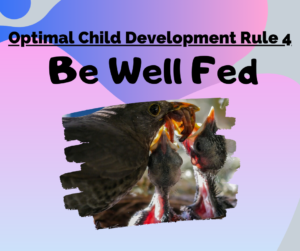 and use the nutrients required for brain growth is crucial if we are going to bring about maturity.
and use the nutrients required for brain growth is crucial if we are going to bring about maturity.
Absorbtion is often affected by many things and at times we have discussed clean water, removing toxic cooking utensils (aluminum and telfon pots and pans), changing some dietary pieces that cause inflammation, adding supplements like the B's for stress managment.
If there is something here that is affecting the child, we will talk about it.
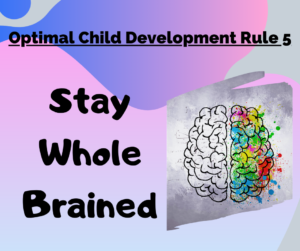
Staying whole brained is the best way to be your best self. It is the means to achieving your goals and relating well to others.
Having this skill as a habit is the ultimate success, as it means that you can approach any task, understand it as a whole and then sequence the smaller tasks so that they can ALL be completed and the end product can be enjoyed. This ability is needed for school, for work and for raising a family.
The first 5 factors all affect the attainment of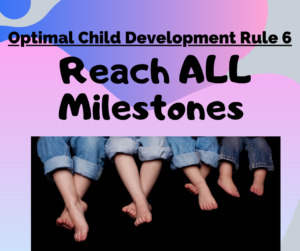 every milestone. Milestones are brought about by primitive reflexes and they revolve around creating a circle of stability and then mobility and then changing plane (lying to sitting to kneeling to standing) and doing it again.. stability into mobility and repeat.
every milestone. Milestones are brought about by primitive reflexes and they revolve around creating a circle of stability and then mobility and then changing plane (lying to sitting to kneeling to standing) and doing it again.. stability into mobility and repeat.
These processes link to academic function by consolidating the internal process of "this feels the same" and "this feels different." If you have several "same" and "different" items, you begin to have catagories, and then you can sequence these. The basis for every academic task is in this little skill brought about by primitive reflex activity.
We look very closely at the milestones that are completed. If the milestone was completed successfully, the child will be able to the milestone task effectively - such as crawl, or run, or separate fingers. There are criteria that determine effective completion. There are standards!!
The gaps will tell which parts of the brain have not grown enough yet, and usually they give us the reason for the difficulties being experienced.
Because brain connections are most effectively made by moving, we use movement to grow the missing pieces. Yes - they are very specific movements because we want specific parts to grow. We need the control pieces for regulation, we need the "stop" pieces to be able to change direction or stop talking so much.
The movements are specific and if they are entirely missing from the child's repetoire, it will probably take a bit longer to master than the pieces that just need to be brought up to standard.
So I guess a discussion of Primitive Reflex action is appropriate. Please click here for this.